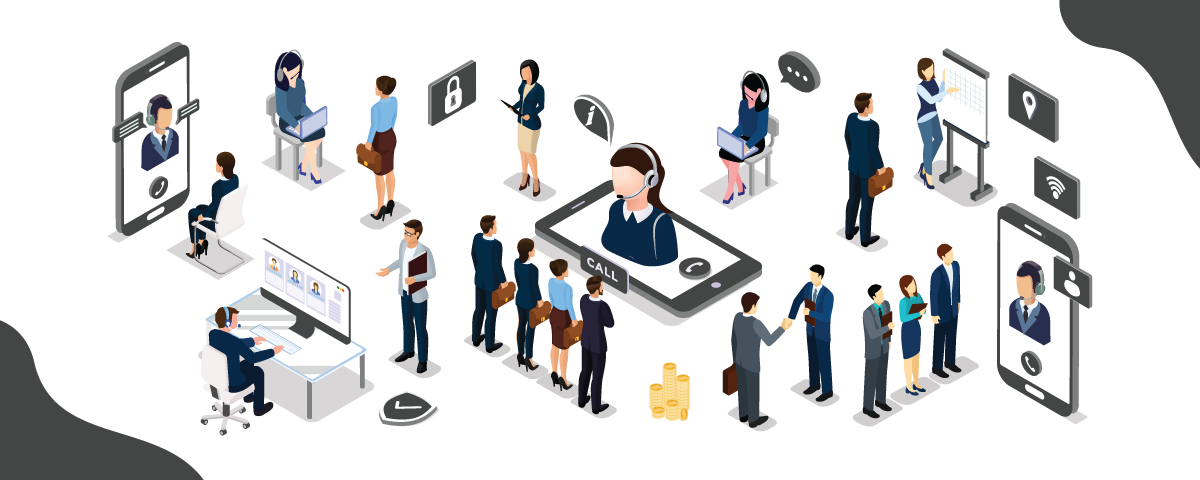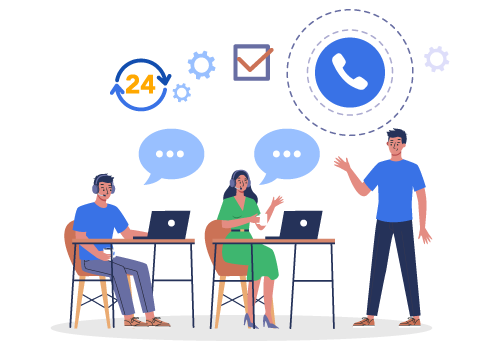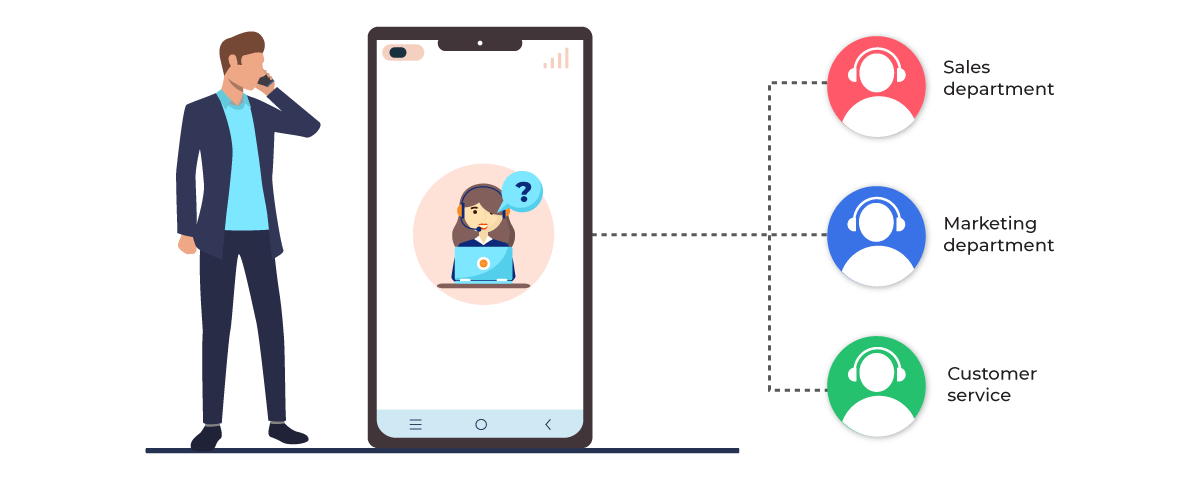Blended call centers are revolutionizing the customer support sector by incorporating both outgoing and incoming calls through the same call center. But wait, aren’t phones supposed to support both types of calls simultaneously?
While this may hold true for your handheld device, it is not the case with call centers. Contact centers must be well-equipped to handle multiple calls and inquiries simultaneously. As a result, intelligent routing software often offers either the inbound or outbound calls option to manage the high volume of interactions.
However, in recent years, technology has made gigantic leaps that enables call centers to support outbound and inbound calls through the same communication line. Consequently, you can offer your customers a consistent and seamless experience. After all, companies making $1 billion annually can expect to earn an additional $700mn within 3 years of investing in customer experience.
This is what blended call centers can contribute to. By the end of this guide, you will know all about blended call center solutions, including their features, benefits, challenges, setup procedure, and best practices.
What Is a Blended Call Center?

Blended call centers are equipped to handle both outgoing and incoming calls. These centers are highly flexible and are operated by professionally trained agents. Depending on the call type and marketing strategy, the agents can be enthusiastic salespersons or empathetic customer support executives.
With blended call centers, your agents will not be limited by inbound or outbound calls. They can do both. Agents won’t have to wait for your customers to reach out for support (as with inbound contact centers); they can proactively check in with customers, leading to higher customer satisfaction.
The software such call centers utilize has an automatic call distribution feature to manage the overflow of customer inquiries and an intuitive calling feature to contact prospects at different stages of their lifecycle.
Benefits of A Blended Call Center Solution
Equipped blended call centers offer higher customer satisfaction for your customers and increased efficiency for your agents. There are several other benefits of running a blended call center service.

1. Increased revenue
Blended contact centers open new avenues for upselling and cross-selling, leading to more sales. Having interacted with the same blended agents during inbound and outbound calls, customers are likelier to listen to their recommendations.
Also, blended models integrate several communication channels like live chat software to help you significantly reduce operating, overhead, and overtime costs, increasing revenue.
2. Better customer satisfaction
Blended call center solutions provide unrestricted agent access to customers via features like two-way communication, custom scripting, and chat capabilities. Uncompromised availability, quickly resolving customer complaints, and instantly answering customer queries inevitably improve customer satisfaction. Not just that, blended solutions are known to reduce average wait time, which further adds to customer satisfaction.
3. Higher productivity and efficiency
Blended call center solutions help agents seamlessly switch between inbound and outbound calls, route calls to qualified agents, and even include remote agents when needed. This massively optimizes agents’ time, leading to zero (agent) idle time and higher efficiency.
In a blended call center environment, whenever an agent is unavailable to take the call, the customer is instantly redirected to the next free agent. With this approach, the customer experiences reduced wait time, and the number of calls handled by the agents also significantly increases, leading to higher productivity.
4. Efficient real-time monitoring
Blended call center software enables you to monitor calls in real time, so you can empower your agents with critical information at the right time. This leads to better customer satisfaction and improved decision-making. Combining real-time and historic data will give you insight into real-time issues so you can solve them on the spot.
Essential Features of A Blended Call Center Solution
Robust blended call center features lead to the compelling list of benefits mentioned above. These features include:
1. Power dialer: Automatically add numbers to your queue and dial them sequentially to maximize calling efficiency and fulfilling daily calling commitments.
2. Smart call forwarding: Forward calls to several phones to always remain reachable.
3. Call Queuing: Place incoming calls in an incoming call queue when busy attending to other customers.
4. Call Transfer: Redirect a connected call to a team member.
5. Call conferencing: Add a third person to your two-way call.
6. Call monitoring: Silently monitor calls in real time.
7. Call barging and whispering: Enter the conference bridge as a supervisor or hear customer queries and provide a quick solution for agents to immediately resolve the issue.
8. Call recording: Record all calls to better monitor your performance.
10. Automatic call distribution: Route calls to best-suited agents to improve first-call resolution rate.
11. Skill-based routing: Automatically direct incoming business calls to best-suited agents.
12. Call Center Analytics: Make data-driven decisions for better team efficiency and customer experience. Right decisions are the driving force of your business; learn all about call center analytics to always make profitable decisions.
How To Set Up a Blended Call Center?
Now that we know how blended call centers can add to your business, let’s follow these steps to set up a blended contact center.

Step 1: Setting up access for your agents
This step is crucial for all the inbound calls in your blended contact centers. Decide whether you want the customer and prospects to connect directly with your contact center agents or use an Interactive Voice Reponse (IVR). An IVR is an automated voice assistant that sends a welcome message and offers the options menu. You can even set up multilevel choices in your IVR system.
Some IVRs can also handle general inquiries, book reservations, cancel tickets, and troubleshoot common problems. Of course, the IVR can also re-route calls to real agents if the prospects are dissatisfied with the pre-recorded solutions. In this step, you must also set up for diverting after-hours phone calls to a different set of agents or voicemail.
Step 2: Agent IDs
Now, create a database for your contact center agents. You can assign them nicknames, agent IDs, or email IDs or simply use their name to save their profile. CRM users have the upper hand as they can reuse their employees’ CRM IDs as agent IDs. 95% of customer service providers believe that having a CRM massively boosts productivity. After completing the second step, you can seamlessly transition into the next one, which is skill-based grouping.
Step 3: Grouping them according to skill levels
As a blended call center, you can expect different calls from prospects and customers with different requirements. Creating different skill groups to tackle these problems and sales queries will make it more efficient for your brand. The number of groups and skill-based agent segments purely depends on the number of employees you have. For example, agents with more product experience can be grouped and assigned to customers with more complex problems.
Step 4: Optimizing your Automated Call Distribution
Since cloud-based contact centers can be situated worldwide, you need a powerful Automated Call Distribution (ACD) system to organize the inbound traffic. These ACD systems can drastically reduce wait time for callers and improve their overall experience. Integrating the ACD systems with your CRM software will help you identify high-priority customers and move them up the queue to deliver unmatched customer support.
Some ACD software also sports a sticky agent feature that enables you to assign the same agent to the callers to improve satisfaction levels. As per GetFeedback’s latest report, 3/4th of marketers strive to add more personalized experience to their customer service.
Step 5: Defining data format for a better dialer experience.
You must explain your data format to your dialers when running outbound campaigns. Once the dialer understands your outbound calling strategy, it will automatically find the phone numbers from your database and dial the calls. This, in turn, reduces dialing time and eliminates human error.
Step 6: Feedback Collection
Establishing a customer feedback response sheet is one of the most important steps of the setup process. You can either end the call with a simple CSAT survey or send a link to the customer’s phone number to collect the feedback.
New to the business? Learn all about setting up a call center.
Blended Contact Center Solution Best Practices You Should Implement
These best practices are key to leveraging a blended call center’s extensive benefits and features.
1. Extensive introductory training and ongoing coaching
You must provide comprehensive training to your agents on blended call center services and a blended call center solution. To tackle high attrition rates, prepare newer employees as quickly as possible. This is also the time to learn about your agent’s weaknesses and offer them the resources to overcome them. Also, imbibe a coaching culture in the agents to encourage learning and helping others.
2. Intuitive call center software solution
Blended call center software are usually more advanced than unidirectional call applications. As a result, you get access to some niche features and tools to enhance the experience for your customers. For example, some contact center software systems offer a call whispering tool that allows the managers to hop on calls to guide the call center agents and take over the calls whenever needed.
Read on to choose the best call center software for your business.
3. Leverage software metrics to improve your operations
Like any other business department, the performance of the blended call center services needs to be monitored. Constantly measuring the KPIs and ROIs prevents you from becoming complacent and helps you consistently improve your services. Average handle time, call abandonment, agent scheduling, voice call resolutions, and average hold time are some key metrics you should focus on.
Challenges of Running A Blended Call Center
As effective as they are, blended call centers have their fair share of challenges that you must overcome to leverage their benefits.
1. High attrition rate
The working hours are long, and the environment can be stressful with regular targets. Accordingly, the contact center industry is plagued with a high attrition rate. Blended agents leave without serving their notice period and often without even submitting a notice.
2. Financial constraints
With a high agent turnover rate, you must constantly spend money on acquiring and training new human resources assets. In the long run, it can cost the company a fortune. Some companies avoid setting up a blended call center to prevent this financial drain.
3. Technical challenges
As with any other tech-heavy department, blended contact centers also constantly face technical challenges. The phone lines can get jammed on truly busy days, and even the ACDs might fail to optimize the queues. These technical gremlins can decrease productivity and increase customer frustration.
4. Poor customer service
Customers will start approaching the support department with more complex issues as the business grows. Sometimes, these customer concerns take longer to solve, thus decreasing customer satisfaction levels. According to research, 44% of customers get annoyed when kept on hold for 5-15 minutes.
Wrapping Up
We now know that blended call centers come with their benefits and challenges. But with blended call center software solutions, you can capitalize on the benefits and eliminate the challenges.
With robust features such as automatic call distribution, skill-based routing, call queuing, IVR, real-time custom and historical custom reports, predictive dialer, power dialer, and so much more, you can leverage all the benefits leading to high customer satisfaction and agent efficiency. That’s the goal, right? So wait no more and invest in the capabilities of a blended call center today.
Explore Our Video : Call Center Phone System
FAQs
1. What does blended mean in a call center solution?
Any call center that handles incoming and outgoing calls is known as a blended call center. You can convert your existing call center into a blended one with a small software change and an agent training program.
2. What are blended call center examples?
Examples of blended call centers include retail phone counters, sales and services centers, and multiple-channel operations.
3. What is a blended agent?
An agent who can handle different customer or prospect interactions on multiple channels is a blended agent. This includes handling inbound and outbound calls, emails, social media, and chats.
4. What are the 4 types of call centers?
Inbound, outbound, blended, and virtual are four types of call centers.

Subscribe to our newsletter & never miss our latest news and promotions.









